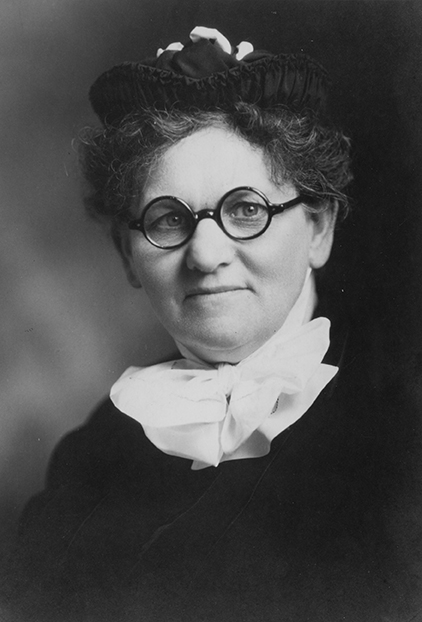Written by Stan Ingersol
From his column Past to Present

West Coast Nazarenes authorized the office of deaconess early on. Miss Arabella Widney, a charter member of Los Angeles First Church, had been a Methodist deaconess, and the church’s official board authorized continuation of her ministry at its second meeting on December 4, 1895. At that same session, they authorized creation of a deaconess certificate and raised a committee to recommend suitable deaconess garb.
The minutes also specified the duties of a deaconess: “care for the sick and poor, pray with the dying, comfort the sorrowing, [seek] the wandering and the lost to bring them to Christ.”
In January, that same board voted to recognize Miss Widney’s Methodist certificate and also approved Emma Stine and Mrs. Croft as deaconesses.1 Los Angeles First Church now had two pastors (Phineas Bresee and J. P. Widney) and three deaconesses.
A deaconess was a female lay minister. Clergy were ordained; deaconesses were consecrated. Clergy preached; a deaconess could preach when warranted but engaged primarily in social and pastoral care ministries.
Edith Whitesides emerged as a prominent Nazarene deaconess who “left a trail of blessing from one coast to the other.”2 Her career as a lay minister embraced advocacy, field work, preaching, and pastoral care.
Edith Hamilton was born in Albion, Nebraska, in 1872. Her family moved to Oregon in the 1880s and she was living in Portland by 1892. She married Alfred Whitesides, a drayer (transporter of heavy goods), in 1894. They had three children.
In early 1905, Edith professed entire sanctification in a Portland meeting conducted by evangelist and assistant general superintendent C. W. Ruth. She soon joined in the National Holiness Association work in that city.
In 1906, she and others invited Bresee to Portland, where First Church was organized on July 4, across from a brewery. Edith joined 27 other charter members that day.
She felt a distinct call to Christian service and became the first deaconess consecrated by the Nazarenes in the Northwest. A lively woman, her ministries expanded, and her example inspired other women so that by 1914 the district had 22 deaconesses.
She was an influential congregant who chaired committees and even the church board when it considered the pastor’s call for the following year. In March 1917, the church board voted her to be “a committee of one” to present one of its financial proposals to the congregation the following Sunday.
She was president for 11 years of the Oregon Holiness Association, which sponsored the largest holiness camp meeting west of the Rocky Mountains, and she was president of the Multnomah County Women’s Christian Temperance Union.
H. Orton Wiley visited Portland in 1919 soliciting support for the Nazarene Sanitarium and Hospital in Nampa, which was associated with Northwest Nazarene College. Edith made a substantial donation in memory of her 13-year-old son who had recently died. Her interest in the hospital grew, and she joined its board of directors in 1920. She also became its field representative, traveling to churches to advocate and raise funds on its behalf.
She helped organize North Pacific District’s Woman’s Missionary Society and was its first president. In 1922, the WMS executive committee tapped her to be one of the denomination’s seven missions advocates and organizers. Assigned to the Northwest, she began organizing mission conventions and district and local WMS societies.
A deaconess usually acted locally. Edith’s itinerary, though, shows she had a wider canvas. In March 1922, she conducted revival meetings in Idaho with evangelist Stella Crooks. In April, she was in Emmett, Idaho, with Dr. Thomas Mangum and a quartet from NNC. In 1922 and 1923, she helped to conduct October revival meetings in Billings, Montana, first for Rev. A. J. Kring and then for Rev. Lewis T. Corlett. She was in Boston in October 1928, preaching at an evangelistic convention at Judson Square with J. B. Chapman and C. W. Ruth. In August 1931, she was in Franklin, New Hampshire, taking a turn preaching in a tent revival meeting.3
In the late 1930s, she became an associate pastor in Springfield, Mass., and is credited with helping to start six churches on the New York and New England districts.
She travelled to Bellaire, Ohio, in September 1939 to begin a revival campaign. She was to preach on September 8, but she lost consciousness while the choir sang “Zion’s Hill.” She had died at age 67. The New England District conducted a funeral service for her in Springfield, Mass., and another was held in Portland, where she is buried near her husband and youngest child.
Stan Ingersol is manager of archives for the Church of the Nazarene.
1Carl Bangs, Phineas F. Bresee: His Life in Methodism, the Holiness Movement, and the Church of the Nazarene (1995): 205-206.
2Journal of the New England District Assembly, 1940: 45.
3Mountain Home Republican (April 1, 1922): 3; Emmett Index (April 13, 1922): 1; Oregon Daily Journal (Sep. 2, 1922): 5; The Billings Gazette (Oct. 23, 1923): 4; Ibid (Nov. 21, 1924): 3; and Boston Globe (Oct. 2, 1928): 14; Other Sheep (Nov. 1931): 15;
